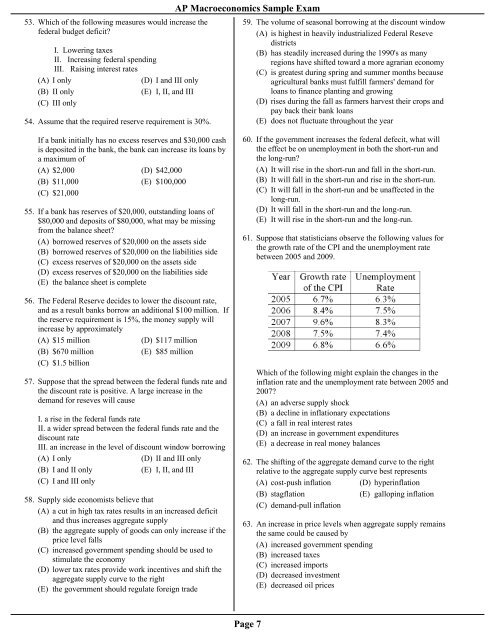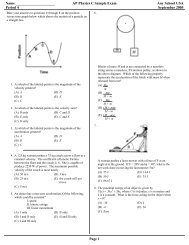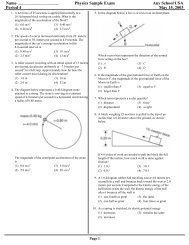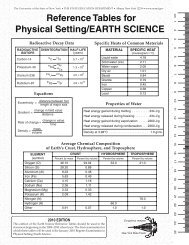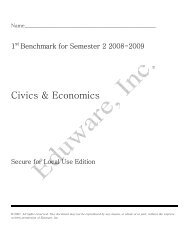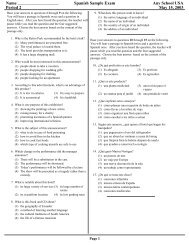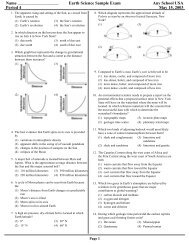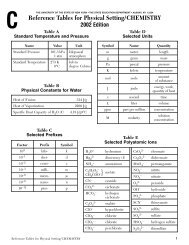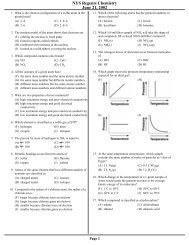The Wizard Test Maker - Eduware
The Wizard Test Maker - Eduware
The Wizard Test Maker - Eduware
Create successful ePaper yourself
Turn your PDF publications into a flip-book with our unique Google optimized e-Paper software.
53. Which of the following measures would increase the<br />
federal budget deficit<br />
I. Lowering taxes<br />
II. Increasing federal spending<br />
III. Raising interest rates<br />
(A) I only<br />
(D) I and III only<br />
(B) II only<br />
(E) I, II, and III<br />
(C) III only<br />
54. Assume that the required reserve requirement is 30%.<br />
AP Macroeconomics Sample Exam<br />
59. <strong>The</strong> volume of seasonal borrowing at the discount window<br />
(A) is highest in heavily industrialized Federal Reseve<br />
districts<br />
(B) has steadily increased during the 1990's as many<br />
regions have shifted toward a more agrarian economy<br />
(C) is greatest during spring and summer months because<br />
agricultural banks must fulfill farmers' demand for<br />
loans to finance planting and growing<br />
(D) rises during the fall as farmers harvest their crops and<br />
pay back their bank loans<br />
(E) does not fluctuate throughout the year<br />
If a bank initially has no excess reserves and $30,000 cash<br />
is deposited in the bank, the bank can increase its loans by<br />
a maximum of<br />
(A) $2,000 (D) $42,000<br />
(B) $11,000 (E) $100,000<br />
(C) $21,000<br />
55. If a bank has reserves of $20,000, outstanding loans of<br />
$80,000 and deposits of $80,000, what may be missing<br />
from the balance sheet<br />
(A) borrowed reserves of $20,000 on the assets side<br />
(B) borrowed reserves of $20,000 on the liabilities side<br />
(C) excess reserves of $20,000 on the assets side<br />
(D) excess reserves of $20,000 on the liabilities side<br />
(E) the balance sheet is complete<br />
56. <strong>The</strong> Federal Reserve decides to lower the discount rate,<br />
and as a result banks borrow an additional $100 million. If<br />
the reserve requirement is 15%, the money supply will<br />
increase by approximately<br />
(A) $15 million<br />
(D) $117 million<br />
(B) $670 million<br />
(E) $85 million<br />
(C) $1.5 billion<br />
57. Suppose that the spread between the federal funds rate and<br />
the discount rate is positive. A large increase in the<br />
demand for reseves will cause<br />
I. a rise in the federal funds rate<br />
II. a wider spread between the federal funds rate and the<br />
discount rate<br />
III. an increase in the level of discount window borrowing<br />
(A) I only<br />
(D) II and III only<br />
(B) I and II only<br />
(E) I, II, and III<br />
(C) I and III only<br />
58. Supply side economists believe that<br />
(A) a cut in high tax rates results in an increased deficit<br />
and thus increases aggregate supply<br />
(B) the aggregate supply of goods can only increase if the<br />
price level falls<br />
(C) increased government spending should be used to<br />
stimulate the economy<br />
(D) lower tax rates provide work incentives and shift the<br />
aggregate supply curve to the right<br />
(E) the government should regulate foreign trade<br />
60. If the government increases the federal defecit, what will<br />
the effect be on unemployment in both the short-run and<br />
the long-run<br />
(A) It will rise in the short-run and fall in the short-run.<br />
(B) It will fall in the short-run and rise in the short-run.<br />
(C) It will fall in the short-run and be unaffected in the<br />
long-run.<br />
(D) It will fall in the short-run and the long-run.<br />
(E) It will rise in the short-run and the long-run.<br />
61. Suppose that statisticians observe the following values for<br />
the growth rate of the CPI and the unemployment rate<br />
between 2005 and 2009.<br />
Which of the following might explain the changes in the<br />
inflation rate and the unemployment rate between 2005 and<br />
2007<br />
(A) an adverse supply shock<br />
(B) a decline in inflationary expectations<br />
(C) a fall in real interest rates<br />
(D) an increase in government expenditures<br />
(E) a decrease in real money balances<br />
62. <strong>The</strong> shifting of the aggregate demand curve to the right<br />
relative to the aggregate supply curve best represents<br />
(A) cost-push inflation (D) hyperinflation<br />
(B) stagflation<br />
(E) galloping inflation<br />
(C) demand-pull inflation<br />
63. An increase in price levels when aggregate supply remains<br />
the same could be caused by<br />
(A) increased government spending<br />
(B) increased taxes<br />
(C) increased imports<br />
(D) decreased investment<br />
(E) decreased oil prices<br />
Page 7


